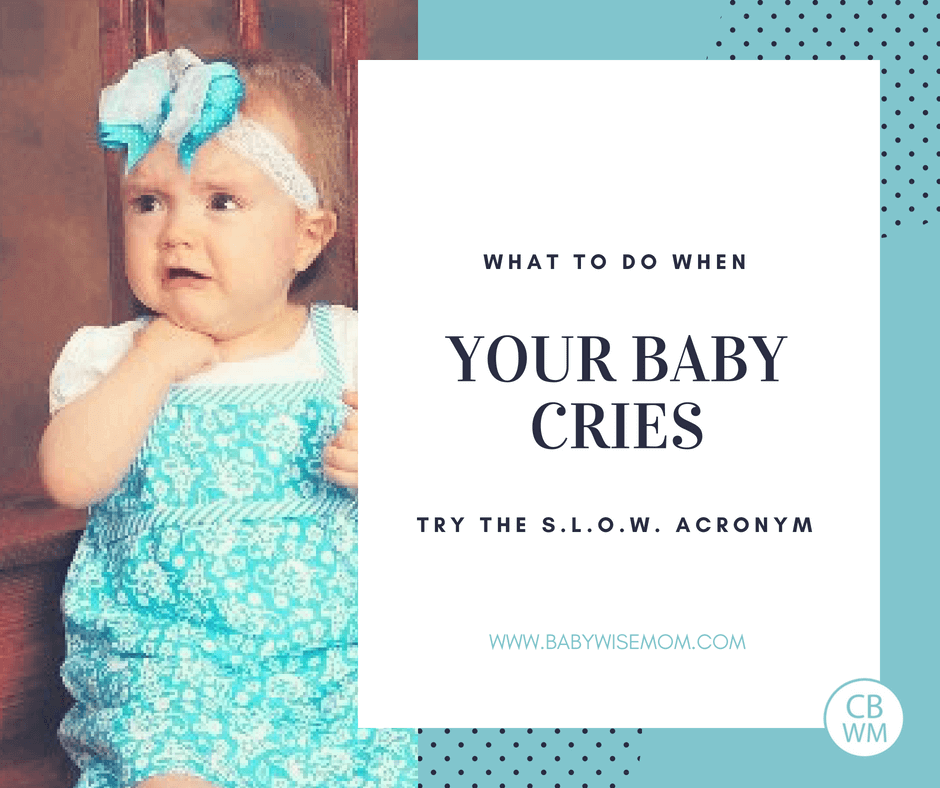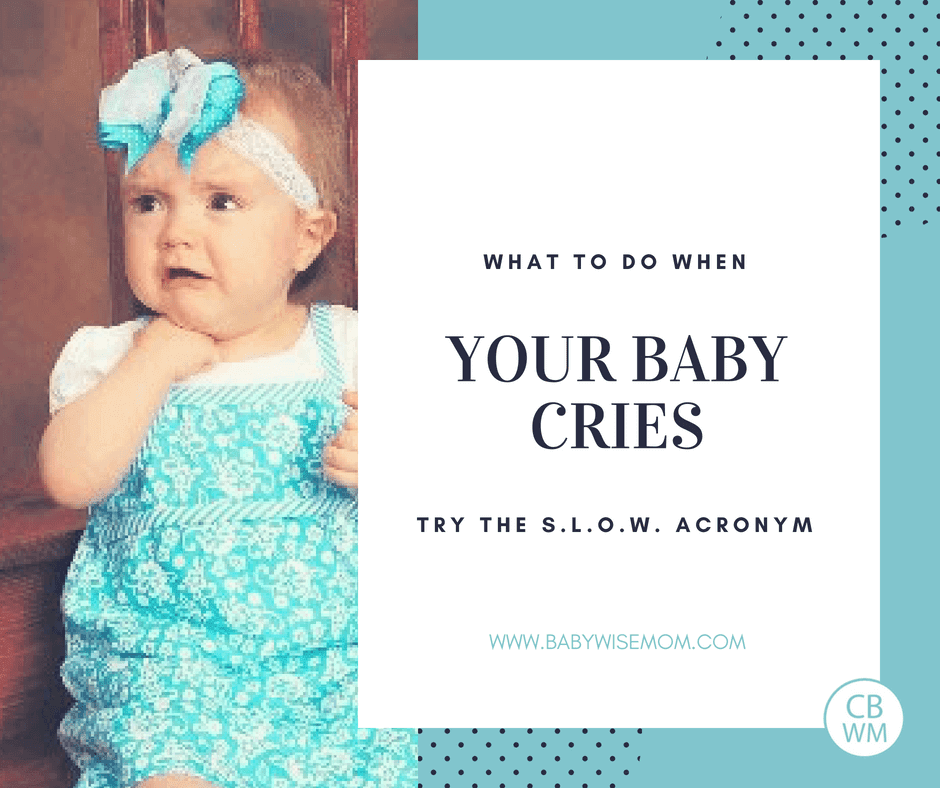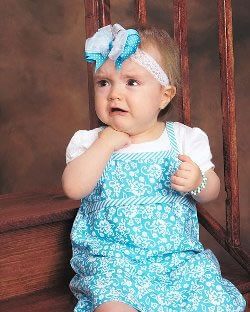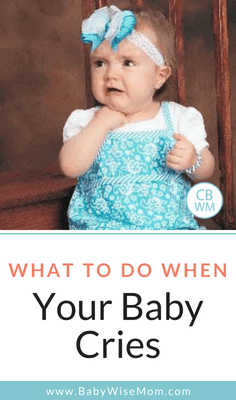What To Do When Your Baby Cries {S.L.O.W.}. This acronym from Tracy Hogg, The Baby Whisperer, will help you to respond in the way your baby needs when your baby cries.


S.L.O.W. is discussed starting on page 65 of Secrets of the Baby Whisperer (affiliate link). S.L.O.W. is the acronym used by Hogg to help parents stop and think before acting when their baby cries.
- S: Stop. Remember that crying is the way your baby communicates.
- L: Listen. Figure out the reason for the crying. What is your baby trying to communicate?
- O: Observe. What is your baby doing? What was he doing before crying?
- W: What’s up? Based on what you hear and see, evaluate and respond.
Through this acronym, you can more easily learn how your baby communicates. It is hard for parents to not respond immediately. We aren’t talking a long period of time, just enough to assess the situation. If you do this before responding, you are more likely to respond accurately.
Post Contents
The Baby Whisperer S.L.O.W. Acronym to Respond to Baby’s Crying
Stop
There are several reasons Hogg lists for stopping:

- Your baby can learn to communicate. If given the chance, a baby can learn that what she says is understood and really communicate from a very young age. If you respond to what she is asking, she will see that what she communicates is understood. Through this, your child will strive to improve communication efforts. I have found this to be true with my children.
- Your baby will develop self-soothing skills. When Brayden was a newborn, my mom told me that I needed to realize that from that moment I was raising him so that he can one day leave me and survive on his own. This includes physically, morally, socially, and emotionally. That doesn’t mean he leaves and never talks to me again, but my job is to teach him to become self-sufficient. If you always rush in, you aren’t giving him a chance to figure it out on his own. This is something that is so hard for me. I really have to hold myself back from interfering with my kids when they are struggling. I have been much better with Kaitlyn than Brayden, and she is much better at problem solving at this age than Brayden was. Also remember the idea of starting as you mean to go on. You can break yourself of this habit (I know personally), but it is easier for everyone if you start from the beginning (I also know this personally).
- You will learn your babies language. As I stated above, stopping and thinking first can help you to learn your baby’s cries faster.
Listen
Here are some suggestions to help you listen.
- Consider the time of day. Is it naptime? Is naptime over? Is she playing and now bored?
- Consider the context. What else is going on around your baby. Was the dog barking? Were there strong smells in the house from cooking? Did it get cold or hot? Was he overstimulated by the activities around him?
- Consider yourself. How are you feeling? Your baby knows you better than you know yourself oftentimes, and she will pick up on your emotions. Have you heard the phrase “If Mama ain’t happy, ain’t nobody happy”? Other than the grammatical problems with that phrase, it is a good one. Very true. That puts a lot of the burden on mom to learn to be happy through any situation. Also, be aware that you can project feelings on your child that she isn’t feeling.
Here are some things that might interfere with your ability to listen:
- You have someone else’s voice in your head. You have people telling you what to do, what you should be doing, etc. You also have your observations and ideas of what a good parent is and isn’t.
- You attribute adult emotions to your crying baby. Hogg points out that babies don’t cry out of sadness, desire to manipulate, desire to ruin your day, etc. Babies cry to communicate hunger, boredom, fatigue, discomfort, etc.
- You project your own motives or problems onto your baby. If you hate to be alone, you might assume your baby is crying because she is alone. If you are nervous in the dark, you might assume your baby is scared of the dark. Know yourself and your own fears and then try to figure out your child as an individual. Remember to listen to what your baby needs rather than react to your own emotions.
- You have a low tolerance for the sound of crying. This can be because you believe crying equals bad mom. It can be a threshold for noise issue.
- You are embarrassed by your baby’s crying. This is often the case in public or with visitors around.
- You had a difficult delivery. You feel sorry for your baby’s experience and think she is long crying because of it.
Observe
To observe it helps to not only hear the cry and evaluate it, but also to look at your baby. Hogg lists several body language actions along with meanings, starting on page 80. This includes actions of the head, eyes, mouth, face, hands/arms, torso, skin, and legs. I will give one example from each section.
- Head. Turns head away from object=baby needs a change of scenery (she is bored)
- Eyes. Stares, unblinking, as if eyes are propped open=over tired and overstimulated
- Mouth. Scream with no sound, finally a gasp the wail=has gas or other pain
- Face. Grimacing, might pant, roll eyes, make an expression resembling a smile=has gas or other pain; is having a bowel movement
- Hands/arms. Flailing and uncoordinated, clawing at skin=overtired or has gas.
- Torso. Arches back, looking for breast or bottle=hunger.
- Skin. Goose pimples=cold
- Legs. Strong, uncoordinated kicking=tired
What’s Up

Remember, a crying baby does not mean you are a bad parent. It is better to learn how to respond to the crying than to stop it with solutions that have nothing to do with the problem. You can teach potential bad habits by doing that. Say baby is bored and you respond by feeding her. That teaches her to eat when she is bored, even if she isn’t hungry.
This will all take you practice, but you can get it. Here are some other posts of mine that elaborate on ideas in this post:
- Get To Know Your Child’s Personality
- Tantrums: Stop and Think
- Crying Baby: 6 Weeks and Younger
- Deciphering Crying
Reader Comments:
- Don Denise Sullivan said…
This was a great post. It’s a reminder too for me with an almost 2-yr old. I find myself reacting when he gets mad at another child and pushes them or takes a toy away. It’s only afterward that I realize he’s pushed them because they took a toy from him or something that he feels is an injustice. I have to remind myself not to react and to find out what’s going in the situation before deciding how to handle it. Easier said than done…I have yet to follow my own advice! But this is a good reminder. Thanks!
August 11, 2008 7:20 PM
Plowmanators said…
You are welcome Denise!
August 12, 2008 2:33 PM


